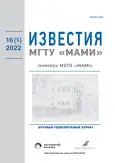Прогнозирование энергетических характеристик обратимой гидромашины на напор до 250 м
- Авторы: Селезнев В.Н.1,2
-
Учреждения:
- Силовые машины
- Санкт-Петербургский политехнический университет им. Петра Великого
- Выпуск: Том 16, № 1 (2022)
- Страницы: 13-19
- Раздел: Гидравлические и пневматические системы
- URL: https://journals.rcsi.science/2074-0530/article/view/104580
- DOI: https://doi.org/10.17816/2074-0530-104580
- ID: 104580
Цитировать
Полный текст
Аннотация
Обоснование. В настоящее время в зоне напоров 50–650 м для ГАЭС наибольшее распространение получили гидроагрегаты с классическими одноступенчатыми радиально-осевыми обратимыми гидромашинами, которые имеют сравнительно простую конструкцию рабочего колеса и цилиндрического направляющего аппарата, достаточно хорошие энергетические показатели, но являются относительно тихоходными, крупногабаритными и металлоемкими гидромашинами. Численным исследованиям при проектировании данного типа машин сегодня уделяется особое внимание.
Современная тенденция – проектирование проточных частей на основе численного моделирования течения. Самые известные коммерческие программные продукты, где реализовано численное моделирование методом конечных объемов – это Ansys Fluent, Ansys CFX, StarCD, Numeca, Flow Vision и CADRUN. В рассматриваемой работе расчеты были выполнены с использованием программного комплекса Ansys CFX версии 2021R1. На сегодняшний день, ввиду нехватки численных мощностей, остается актуальной задача разработки и использования методики, которая позволит получить приемлемый результат при оптимальных временных затратах на подготовку данных и проведение расчетных исследований.
Цель исследований. В работе представлена «экономичная» методика численного моделирования энергетических характеристик обратимой гидромашины.
Методы исследования. Методика заключается в описании постановки задачи, используемых расчетных сеток и принятых допущений для оптимального использования вычислительных ресурсов без существенной потери точности результатов.
В представленной статье исследуется проточная часть радиально-осевой насос-турбины, предназначенная для применения на максимальный напор до 250 м.
Результаты. Выполнено численное моделирование энергетических характеристик насосного и турбинного режимов. Дано краткое описание постановки задачи, используемых расчетных сеток и принятых допущений. Представлено сравнение результатов расчетов с экспериментальными данными модельных испытаний. Результаты сравнения представлены в относительном виде для основных параметров: напор, КПД, приведенные частота вращения и расход.
Заключение. Для прогнозирования энергетических характеристик насос-турбин рекомендуется использовать SST модель турбулентности в стационарной постановке. Применение экономичных блочно-структурированных сеток, а также проведение расчетов только в области одной лопатки направляющего аппарата, одной лопасти рабочего колеса и отсасывающей трубы с использованием предварительных результатов расчетов в спиральной камере позволяют оптимально использовать вычислительные ресурсы без существенной потери точности результатов.
Полный текст
Открыть статью на сайте журналаОб авторах
Вячеслав Николаевич Селезнев
Силовые машины; Санкт-Петербургский политехнический университет им. Петра Великого
Автор, ответственный за переписку.
Email: Seleznev_VN@power-m.ru
ORCID iD: 0000-0002-3275-1250
SPIN-код: 1959-9633
магистр, аспирант, ведущий инженер-конструктор сектора гидравлических расчетов
Россия, 195009, Санкт-Петербург, ул. Ватутина, д. 3, лит. А; Санкт-ПетербургСписок литературы
- Синюгин В.Ю., Магрук В.И., Родионов В.Г. Гидроаккумулирующие электростанции в современной электроэнергетике. Москва: ЭНАС, 2008.
- Kaniecki M., Krzemianowski Z. Numerical analysis and laboratory test of a high speed Francis hydraulic turbine. Proceedings of Hydro 2018. Progress through Partnerships; 2018 Oct 15–17; Danzig, Poland. Available from: https://yadda.icm.edu.pl/baztech/element/bwmeta1.element.baztech-b4296277-5386-4d89-944e-425571686c86/c/111-120.pdf. Accessed: Jun 13, 2022.
- Schiffer J., Benigni H., Jaberg H., Ehrengruber M. Reliable prediction of pressure pulsation in the draft tube of a Francis turbine at medium and deep part load: A validation of CFD-results with experimental data. Proceedings of Hydro 2018. Progress through Partnerships; 2018 Oct 15–17; Danzig, Poland. Available from: https://graz.pure.elsevier.com/en/publications/reliable-prediction-of-pressure-pulsations-in-the-draft-tube-of-a. Accessed: Jun 13, 2022.
- Documentation Ansys CFX 2021R1 [Internet]. Available from: https://studylib.net/doc/25536336/ansys-cfx-tutorials-2021-r1. Accessed: Jun 13, 2022.
- Макаров В.В., Пылев И.М., Пьянов В.И. Объемные и дисковые потери в радиально-осевых гидротурбинах // Энергомашиностроение. 1982. № 1. C. 11−14.
Дополнительные файлы














